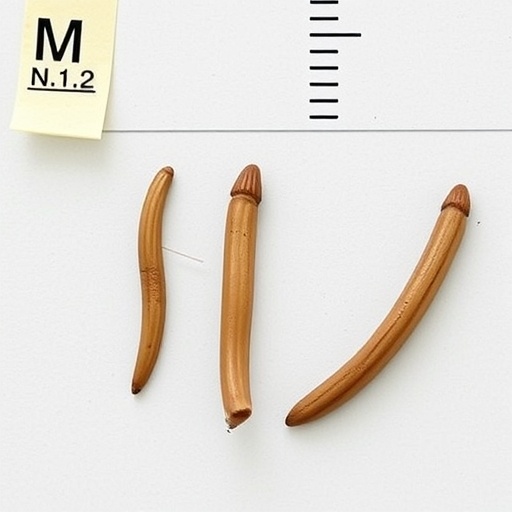In the ever-evolving realm of forensic science, accurate identification of biological materials remains a cornerstone for solving complex investigations. Recently, a groundbreaking study unveiled a meticulous three-step forensic approach designed to distinguish between human fingernail-like fragments and those originating from pigs—a differentiation that has perplexed forensic experts and sometimes hindered justice. This innovative methodology incorporates a blend of macroscopic examination, Raman spectroscopy, and histogenetic analyses, promising a new benchmark in forensic identification techniques.
Fingernail-like fragments recovered from crime scenes can often be enigmatic due to their morphological similarities across species. Pigs, in particular, possess keratinous structures remarkably resembling human fingernails, complicating the analyst’s job during early investigative phases. Traditional visual inspections may fail to reliably discriminate between these materials, risking misinterpretation of crucial evidence. Recognizing this challenge, the researchers embarked on developing a robust protocol to eliminate ambiguity and provide unassailable forensic evidence.
The first step in the forensic protocol is macroscopic examination. Here, forensic specialists undertake a thorough visual and structural assessment of the fragment samples using high-resolution stereomicroscopy. This process involves assessing size, shape, coloration, and surface texture, aiming to identify characteristics indicative of the fragment’s origin. While this phase offers preliminary insights, the researchers quickly realized that visual assessment alone cannot provide definitive differentiation owing to the near-identical external appearances observed.
.adsslot_ULANyoikg6{ width:728px !important; height:90px !important; }
@media (max-width:1199px) { .adsslot_ULANyoikg6{ width:468px !important; height:60px !important; } }
@media (max-width:767px) { .adsslot_ULANyoikg6{ width:320px !important; height:50px !important; } }
ADVERTISEMENT
Raman spectroscopy emerges as the second analytical pillar of the study. This vibrational spectroscopic technique probes the molecular composition of the keratin materials by examining their distinctive scattering of monochromatic light. Since keratin structures possess species-specific biochemical signatures, subtle spectral differences can be detected between human and pig samples. The research team meticulously calibrated Raman spectroscopic equipment to optimize sensitivity, enabling the detection of unique molecular fingerprints that physical observation cannot discern.
By analyzing spectral data, the researchers successfully identified characteristic peaks corresponding to amino acid residues and keratin cross-linking patterns distinctive to humans versus pigs. Notably, human fingernail fragments exhibited spectral features suggestive of specific disulfide bond arrangements and protein conformations differing from pig keratin structures. These findings underscore the power of Raman spectroscopy as a non-invasive, rapid, and precise tool capable of augmenting forensic investigations through biochemical discrimination.
The final phase involves histogenetic analyses to examine the microscopic tissue architecture and cellular components of the fingernail-like fragments. Utilizing advanced histological staining methods and microscopy, forensic pathologists evaluated the internal structural patterns, such as nail matrix organization, keratinocyte distribution, and nail bed morphology. This level of cellular scrutiny illuminated further intrinsic differences between human and porcine samples, which are concealed from macroscopic observation but crucial for definitive species identification.
Histogenetic findings revealed distinctive tissue arrangement patterns consistent with species-specific nail formation processes. Human nail fragments demonstrated a consistent layering of densely packed keratin cells with subtle morphological features absent in porcine samples. This cellular-level evidence corroborated the spectral data, reinforcing the reliability of the combined three-step methodology and mitigating the risk of misclassification.
Together, these three steps—the macroscopic evaluation, Raman spectroscopic profiling, and histogenetic tissue analysis—form a comprehensive forensic approach that surpasses singular methods in accuracy and reliability. This protocol doesn’t merely enhance discrimination between human and pig nail fragments; it sets a precedent for multipronged analytical techniques in forensic science, potentially applicable to other ambiguous biological materials encountered in investigations.
The implications for forensic casework are profound. Misidentification of biological fragments can derail criminal investigations or lead to miscarriages of justice. For example, in scenarios involving animal attacks, postmortem scavenging, or contamination of crime scenes by animal remains, investigators must meticulously verify whether keratinous fragments are pertinent human evidence or environmental contaminants. This method provides a definitive decision-making framework, sharpening the precision of forensic interpretations.
Adopting this protocol can also streamline forensic laboratory workflows. The initial macroscopic examination offers a quick screening step, guiding the necessity for more resource-intensive Raman spectroscopy and histology only when necessary. Such an approach minimizes time and costs while maintaining high standards of evidentiary integrity—a balance critically valued in forensic settings overwhelmed with case backlogs.
Furthermore, the non-destructive nature of Raman spectroscopy ensures that precious forensic samples remain largely intact for potential additional testing or court presentations. Histogenetic analysis, while more invasive, is reserved for confirming ambiguous cases with prior spectral indications, thereby conserving sample integrity wherever possible.
This research underscores the growing convergence between traditional forensic examination and cutting-edge molecular analytical technologies. The hybridization of these disciplines enables forensic scientists to unravel complexities that have historically limited the utility of particular evidence types. As forensic science evolves, integrating multidisciplinary expertise will be pivotal in addressing novel challenges posed by increasingly sophisticated crime scene scenarios.
Beyond forensic investigations, this approach reflects broader biological insights into keratinous tissue diversity across mammals. By elucidating subtle biochemical and cellular differences, the study enriches fundamental understanding within comparative anatomy and molecular biology, showcasing the translational potential of such research.
As forensic laboratories worldwide grapple with novel case types and increasingly intricate evidence, the introduction of this three-step protocol heralds a new era where accuracy is no longer sacrificed for speed or simplicity. The researchers’ contribution, published in the International Journal of Legal Medicine in 2025, anticipates widespread adoption and adaptation of these tools for other forensic challenges.
The study also encourages future exploration into machine learning integration with spectroscopic data for automated classification, potentially further accelerating forensic workflows and reducing human error. Such innovations stand to amplify the procedural robustness outlined in this pioneering method.
In summary, the meticulous fusion of macroscopic, spectroscopic, and histogenetic analyses presents an unprecedented forensic toolkit enabling unequivocal differentiation between human and pig fingernail-like fragments. This advancement not only refines forensic accuracy but also assures greater confidence in courtroom evidence, ultimately contributing to the pursuit of justice with new scientific rigor.
This breakthrough exemplifies how meticulous scientific inquiry can elegantly address practical forensic dilemmas, transforming ambiguous biological fragments into decisive evidence that shapes outcomes of legal investigations worldwide.
Subject of Research: Differentiation of human and pig fingernail-like fragments in forensic investigations.
Article Title: Three-step forensic approach for the differentiation of human and pig fingernail-like fragments: macroscopic examination, raman spectroscopy and histogenetic analyses.
Article References:
Cummaudo, M., Bruni, S., D’Apuzzo, A. et al. Three-step forensic approach for the differentiation of human and pig fingernail-like fragments: macroscopic examination, raman spectroscopy and histogenetic analyses.
Int J Legal Med (2025). https://doi.org/10.1007/s00414-025-03538-7
Image Credits: AI Generated
Tags: advanced forensic protocolschallenges in forensic identificationdifferentiating human and pig fingernailsforensic evidence accuracyforensic science techniqueshistogenetic analysis in forensicsidentifying biological materials in investigationskeratinous structures comparisonmacroscopic examination in forensicsnail fragment analysis methodsRaman spectroscopy applicationsvisual inspection limitations in forensics





